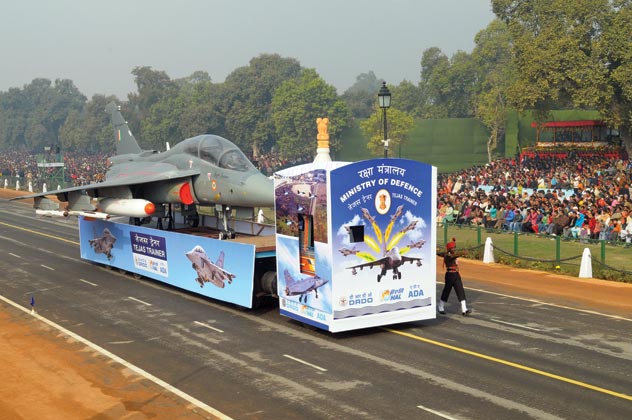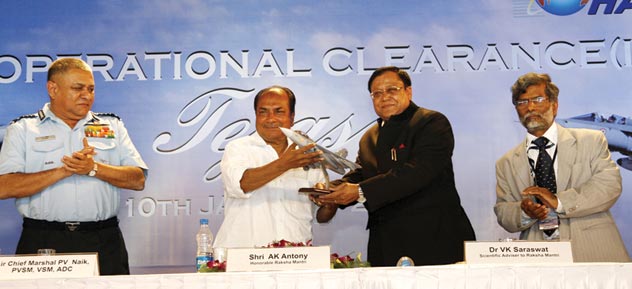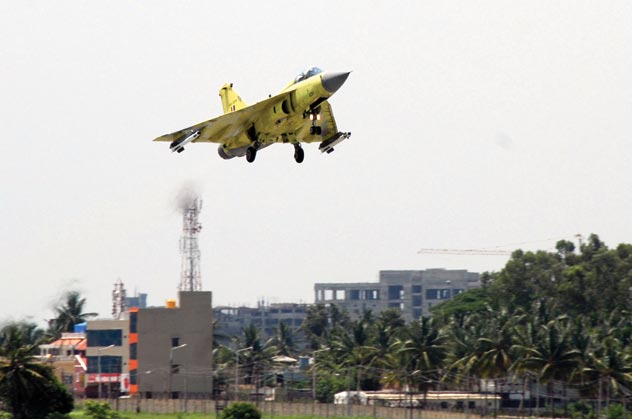SUBCONTINENT:
Milestones in Air Defense: India's Indigenous Fighter Jet
India’s defense hardware capability moved a notch higher this month, with a bit of help from America, as India’s indigenous Light Combat Aircraft Tejas received its initial operational clearance, paving the way for the fighter’s induction into the Indian Air Force by June, writes Siddharth Srivastava.

(Above): The tableau of Tejas Trainer, Ministry of Defense, passes through the Rajpath during the full dress rehearsal for the Republic Day Parade 2011, in New Delhi Jan. 23. India’s indigenous Light Combat Aircraft Tejas is slated for induction into the Indian Air Force by June. [PRESS INFORMATION BUREAU photo]
India’s defense hardware capability moved a notch higher this month, with a bit of help from America.
Earlier this month, India’s indigenous Light Combat Aircraft received its initial operational clearance paving the way for the fighter’s induction into the Indian Air Force by June this year.
Indian Defense Minister A.K. Antony said the country’s IAF and Navy would ultimately deploy 200 such fighters and will replace the ageing and accident prone Russian MiG-21 fleet.
“After accomplishing a series of milestones of envelope expansion, sensor integration and weapon delivery in over 1,500 sorties, the country is poised for a major turning point,” Antony said, adding that the IAF should field 140 aircraft (seven squadrons) by 2020.
The Tejas LCA is expected to get the final operational clearance in the next two years for formation of a squadron by 2013 or early 2014, IAF chief Air Chief Marshal P. V. Naik said.
As has been the case of several domestic defense projects, India’s heavily delayed LCA program was conceptualized in 1983, with the government eventually pumping nearly Rs. 145 billion into the effort that was budgeted at slightly over Rs. 5.5 billion initially.
The present Tejas is said to approximate Sweden’s Gripen. The LCA has suffered major bottlenecks due to sanctions on import of high tech possible dual use technology and equipment imposed by America following nuclear weapons tests by India in May 1998.
Ironically, in a reflection of changed Indo-U.S. equations, the initial 40 Tejas aircraft will be powered by American GE-404 engines while the rest (Tejas Mk-2) will be equipped with the more powerful GE-414 engines.
Future versions of Tejas are slated to be driven by the domestically developed Kaveri aero-engine program with no certainty about the final completion period. The indigenization level in Tejas is presently about 65 percent and is expected to be scaled to 75-80 percent.
India continues to be one of the largest importers of weapons globally due to its inability to develop effective indigenous delivery of weapons systems and emergence of private industry.
In the decade that has followed Kargil, India’s arms purchase deal value has crossed a big $50 billion, with every sign of such momentum being carried over the next decade and crossing $100 billion.
Most observers agree that the performance of the state-owned Defense Research and Development Organization that oversees all defense production has not been up to the mark and there is need to incorporate foreign technology and help.

(Above): The Scientific Adviser to Raksha Mantri Dr. V.K. Saraswat presenting a model of LCA Tejas to Defense Minister A. K. Antony during Initial Operational Clearance function of Indigenous Tejas Light Combat Aircraft at Bangalore Jan. 10. Chief of the Air Staff Air Chief Marshal P.V. Naik is also seen. [PRESS INFORMATION BUREAU photo]
Among the severely delayed DRDO projects include the Main Battle Tank, Arjun, apart from Tejas.
Meanwhile, America is emerging as India’s new military partner as New Delhi looks beyond Russia, India’s traditional supplier dating back to the Cold War era. Problems with Russia include servicing and spare parts delays and obsolete technology.
The U.S., presently India’s sixth-biggest arms supplier, will likely be among the top three suppliers alongside Israel and Russia, in the next few years. France, U.K., Sweden are among the other top defense exporters to India.
Keen to diversify its weapons procurement sourcing, India has told the U.S. to ease its export control restrictions to allow high-end weapons technology tie-ups between the two nations.
Over the last couple of years, the big arms deals inked with America include six C-130J Super Hercules aircraft for almost $1 billion (2007) and eight Boeing P-8I planes for over $2 billion (2009).
India has also acquired Airborne Early Warning Air Craft, Hawkeye E-2D, developed by U.S. firm Northrop Grumman. A multi-billion-dollar deal for American C-17 cargo planes has been approved.
America has also been looking to sweeten defense deals with India to bag new contracts.
Currently, India is in the process of building a fighter jet fleet that will comprise imported multi-role combat aircraft that will fit between the more powerful Russian Sukhoi-30 and the Tejas lightweight fighters.
The competition is stiff for India’s largest ever defense deal, the $12 billion 126 medium MRCA contract, with six players in the fray keen to outdo each other.
Lockheed Martin, Boeing (American), Dassault’s Rafale (French), Gripen (Sweden), MiG (Russian) and Eurofighter Typhoon (a consortium of British, German, Italian and Spanish companies) have begun presenting their fighter jets for flight testing to the IAF.

(Above): The first flight of Tejas LSP-4 at Bangalore Airport on June 2, 2010. [PRESS INFORMATION BUREAU photo]
The Tejas is touted as a fourth-generation fighter, developed by India’s state-run Aeronautical Defense Agency and manufactured by Hindustan Aeronautics Ltd with several public-private tie-ups. Stealth capabilities could upgrade the aircraft to fifth-generation levels.
India has five Sukhoi squadrons in operation, which total around 105 aircraft and aims to possess another 280 such fighters in its fleet.
The country originally ordered 50 Su-30MKIs from Russia in 1996 and additional 40 fighters in 2007. India’s state owned Hindustan Aeronautics Limited is contracted to build 140 more by 2017.
The Russian MIG’s formed the backbone of India’s air strike for a long time. However, technical snags, shoddy servicing and non-availability of spares resulted in many MIGs going down, killing pilots and maiming India’s air force capabilities.
Presently, the Sukhois are predominantly stationed along India’s western peninsular areas bordering Pakistan to protect industrial states Maharashtra and Gujarat.
Due to border tensions with China over territorial rights over north eastern state Arunachal Pradesh, Sukhoi’s have been deployed in adjoining Assam for quicker access to China.
Pakistan, as a former Cold War ally of America and now partner in its war against terror, has, meanwhile continued to receive military aid, that have included state-of-the-art F-16 fighters. Pakistan is also assisted by China, whose military prowess is far ahead of India.
|